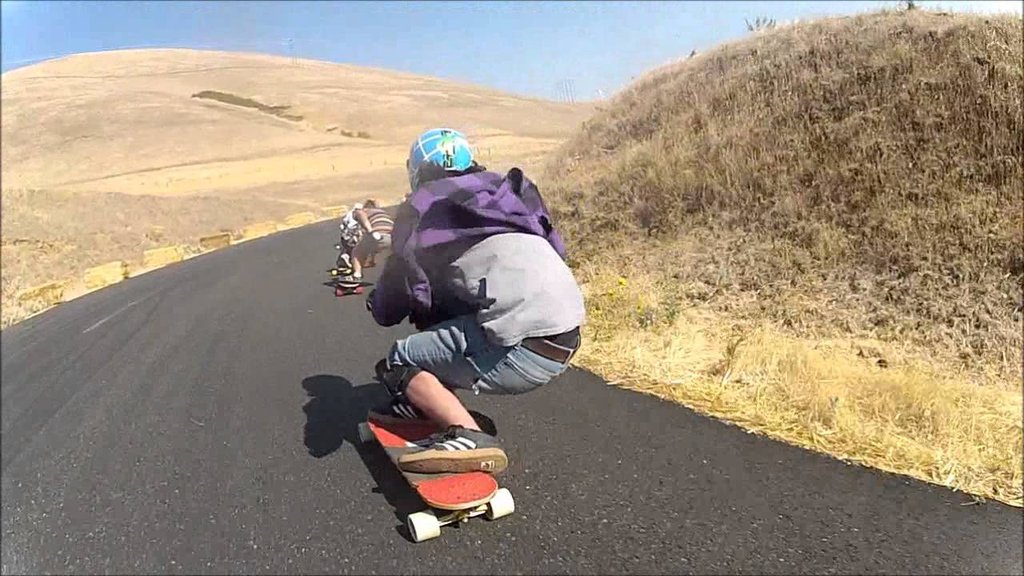I remember my first hill incredibly clearly. I’m not saying the hill that I first rode with that group of longboarders that really made me fall in love with downhill, I’m talking the first really steep and fast hill that I skated. This hill was exhilarating and scary, it was an incline that you could see from the top to the bottom, and I’m going to outline my experiences on this hill (I’ve skated it too many times), and give some constructive advice that will help your downhill longboard game in your first baby steps.
I would define a fast, downhill hill as one where you can reach at least 50 kilometers per hour if you are going down in a full, compact tuck without slowing down. Yeah, it sounds scary but it’s the nature of downhill. You are trying every time to beat your previous speed record on the same hill. It’s the largest motivation for downhill for many people. It is for me. I use GPS applications to track my speed down that hill and every time I skate that hill, I try to raise the average speed by at least 3 kilometers per hour, which gets harder and harder each time, pretty logically.
The first time I went down this hill, I footbraked constantly. This is something that you should do if you aren’t a super experienced skater. When you are going down the hill you should make sure that you know where it slows down, where it is bumpy, where it gets fast and if there are any parts of it that you can’t go down without doing a few slides. Usually, harder runs have corners that you need to predrift, but for most easy to moderate runs, you can grip the whole run.
The second time I went down the hill is when I encountered some problems that I assume a lot of people encounter the first time they go fast down a hill is speed wobbles. Wobbles are a pretty widely known phenomenon where your vehicle turns left and right back and forth rapidly in increasing magnitude until you are thrown off. This is a pretty common for all fast sports, like motorcycle drag racing and even racing cars. In these motorized situations, the solution is usually to go faster by accelerating, but since we are a gravity sport, we don’t have that option. Our only option is to manipulate the way the longboard behaves under our feet.
The universal solution to speed wobbles is to put all the weight on the front of the board, as close to the front truck as possible. So, one of the best ways to do this is to get into a nice, efficient tuck. A tuck is that position that I talk about a lot, where your knee is touching your other calf and your chest is on your front knee. This is extremely aerodynamic. But it is also great for keeping your weight out front, because all you have to do is simply lean forward.
The harder you lean forward, the more stable you will be.
There is a scientific explanation for this. Wobble comes from the back trucks. This is because essentially, if there is more weight in the back, the back trucks are given free roam to twitch as much as they want within the scope of the front truck, meaning that the back will not wobble back and forth, because the front truck is not there to keep it in check. However, when you keep your weight in the front of the board, the back truck is only trailing. It is not doing any steering, it isn’t supporting you at all, it’s just trailing behind the front truck, and much like a trailer behind a truck does.
Other ways that you can reduce wobbles is carving.
I’ve spoken about this in the past. Carving is a very versatile tool that can easily be used to ride out of wobbles. Much like surfing a bad wave, you can catch wobbles at either the right or the left by simply just leaning into it when it happens. At first, leaning into a wobble will be one of the harder things you do. Wobbles are completely unintuitive. They cause panic, they’re very hard to control, but once you have bailed from and experienced many wobbles, you will begin to anticipate them more than be scared of them, much like I have! You can feel wobbles emanating from the back truck most of the time, and an uneasy feeling comes with it. This is when you know you should carve to get rid of a little bit of your speed.
Another thing about going down hills is the fear aspect of it. The first time you go down your hill, you don’t know your limits. My best advice that I have for a starting downhiller is to start near the bottom and work your way up. Footbrake consistently and make sure that you are always at a speed that you are comfortable. Another thing about mentality is that if you aren’t comfortable, it’s pretty easy to make a mistake and crash. I’ve had instances where I was really nervous going down hills and I would overestimate corners, slide when I didn’t have to, miss the corner and run into the grass and crash. Most of my road rash on my body is actually from being nervous.
My way to combat nervousness is walking down the hill and scouting it out before I go down it. This way, I know which sections will be hard and which sections will be a challenge for me. It’s a good way to prepare mentally.
ROAD RASH. Ryan L. Longboarder.
